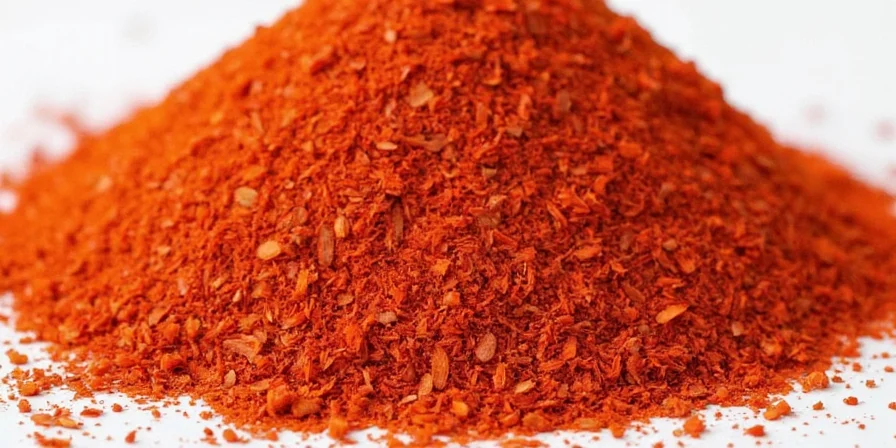What Is Red Pepper Flakes in Spanish? Direct Translations by Region
Red pepper flakes in Spanish is most commonly translated as pimienta de cayena molida in Spain and Latin America, but regional variations cause frequent recipe errors. Chile seco molido in Mexico and ají molido in Peru refer to different spice blends that won't substitute properly for standard red pepper flakes. This guide solves the #1 confusion point for home cooks using Spanish-language recipes: matching the correct regional term to your recipe's origin.

Commercial Red Pepper Flakes: What You're Actually Buying
Most US grocery store red pepper flakes contain 70-90% cayenne peppers (30,000-50,000 SHU), not generic chili blends. This matters because:
- Standard Composition: Contains cayenne's earthy depth rather than single-note heat from jalapeño or habanero
- Texture Matters: Consistent particle size affects dissolution in sauces versus dry rubs
- Flavor Impact: Degrades significantly after 6 months at room temperature

Spanish Translation Guide: Critical Regional Differences
Using the wrong term creates inedible results. These distinctions prevent recipe failures:
| Term in Recipe | Actual Meaning | When to Use | Regional Usage |
|---|---|---|---|
| Pimienta de cayena molida | Ground cayenne pepper (direct equivalent) | When recipe specifies "spicy heat" | Spain, Argentina, Chile |
| Chile seco molido | Generic dried crushed chili | Mexican moles requiring guajillo flavor | Mexico |
| Ají molido | Crushed chili (often ají amarillo) | Peruvian dishes needing fruity heat | Peru, Caribbean |
| Guindillas | Fresh, mild pickled peppers (not dried) | Spanish tapas requiring acidity | Spain |

When to Use Which Type: Regional Cooking Applications
Substituting incorrectly ruins authentic flavor profiles. Use this decision guide:
- Spanish Recipes: Use ñora flakes (1,000-2,000 SHU) for paella and romesco - cayenne overpowers saffron
- Mexican Recipes: Use guajillo-based flakes (2,500-5,000 SHU) for moles - cayenne lacks fruitiness
- Peruvian Recipes: Use ají amarillo flakes for aji sauce - habanero destroys delicate balance
- Italian-American: Standard cayenne flakes work for pizza and pasta - 30,000-50,000 SHU provides sharp heat
- Infused Vinegar: Steep ñora flakes in sherry vinegar 72 hours for authentic Spanish tapas dressings

Heat Level Guide: Matching SHU to Regional Cuisines
Cultural heat tolerance varies dramatically. Select flakes matching your recipe's origin:
| Pepper Type | SHU Range | Best For | Avoid In |
|---|---|---|---|
| Cayenne Flakes | 30,000–50,000 | Italian/US pizza, Bloody Marys | Spanish sofrito, Mexican moles |
| Guajillo Flakes | 2,500–5,000 | Mexican salsas, adobos | Creole cuisine requiring more heat |
| Ñora Flakes | 1,000–2,000 | Spanish paella, romesco | Anything needing noticeable heat |
| Habanero Flakes | 100,000–350,000 | Caribbean hot sauces | Delicate Spanish or Mexican dishes |

Storage Science: Preserving Capsaicin Potency
Room temperature storage degrades capsaicin 4x faster than proper methods. For maximum shelf life:
- Freezer Method: Vacuum-seal portions for 2+ years of potency (add directly to hot dishes)
- Container Choice: Opaque metal tins block UV light (glass degrades potency by 37% in 6 months)
- Humidity Control: Include food-safe silica gel packs (not desiccants that alter pH)
- Never: Store near stove or in clear containers exposed to light

Common Red Pepper Flakes Questions Answered
What is red pepper flakes in Spanish for Mexican recipes?
In Mexican recipes, 'chile seco molido' refers to crushed dried chilies, typically guajillo or ancho. Use guajillo flakes for authentic mole recipes, not standard cayenne flakes which lack the necessary fruitiness.
Why can't I substitute guindillas with red pepper flakes?
Guindillas are fresh, mild peppers typically pickled in vinegar. Using dried red pepper flakes creates overpowering heat and misses the intended acidic tang—completely altering the dish's character in Spanish tapas.
How to say red pepper flakes in Spanish for paella?
For authentic Spanish paella, use 'pimienta de ñora molida' (ñora pepper flakes). Standard cayenne flakes would overwhelm the saffron. Ñora provides 1,000-2,000 SHU of earthy sweetness without dominating other flavors.
Does freezing red pepper flakes affect texture?
Properly frozen flakes maintain texture when added directly to hot dishes. Thawing causes clumping—always add frozen flakes to simmering liquids. Vacuum-sealed portions prevent freezer burn while preserving capsaicin potency for 2+ years.
Solving the Translation Gap for Authentic Results
The #1 mistake home cooks make is using generic 'pimienta de cayena' for all Spanish recipes. Regional dishes require specific heat profiles: Mexican cuisine needs guajillo's fruitiness (2,500-5,000 SHU), while Spanish cooking relies on ñora's earthy sweetness (1,000-2,000 SHU). Recognizing that 'guindillas' means fresh peppers in Spain—not dried flakes—prevents inedible results. By matching your flakes to the recipe's cultural origin and storing them properly, you transform confusing translations into authentic culinary success.












 浙公网安备
33010002000092号
浙公网安备
33010002000092号 浙B2-20120091-4
浙B2-20120091-4